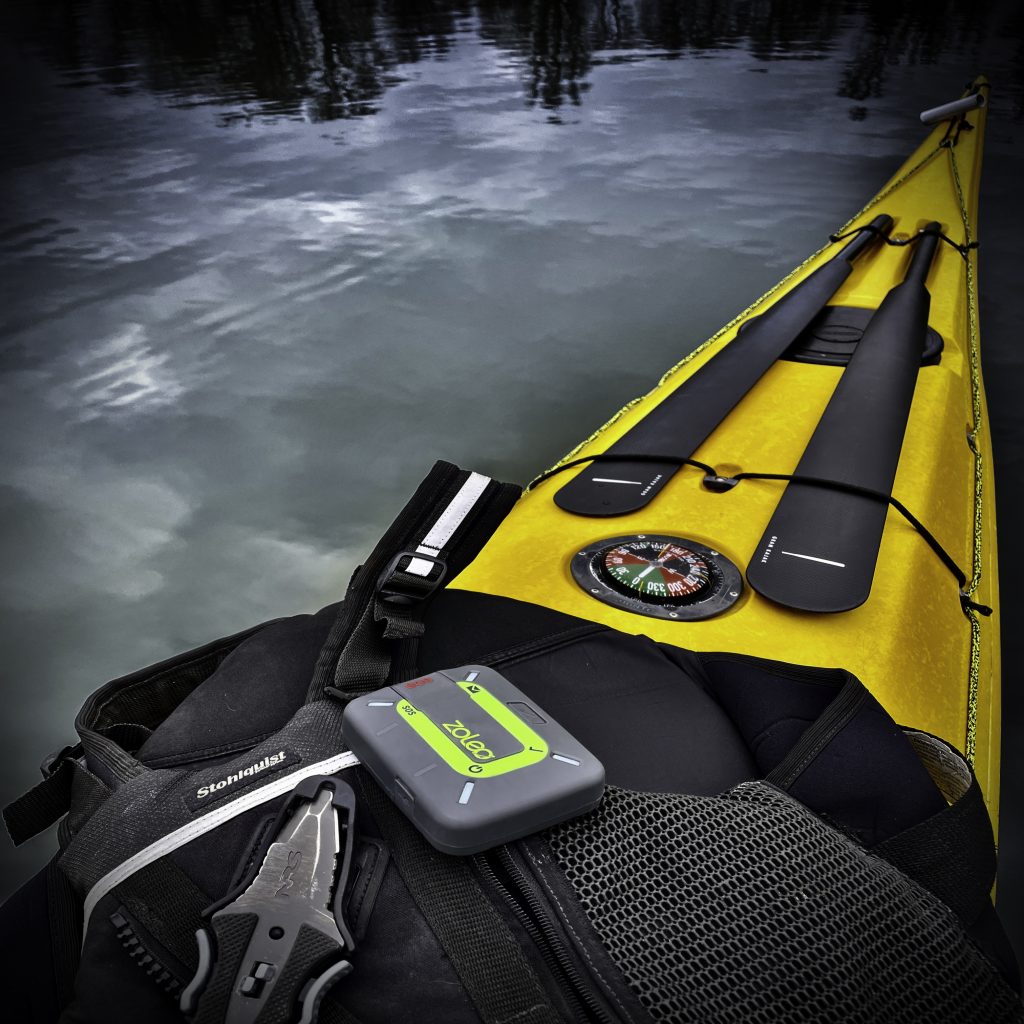‘One of the loneliest places one can be is in the slow drift leading into a stiff rapid. The quiet and calm, the river’s current compressing and picking up speed, and the roaring sound coming from a horizon line falling away in the near distance. No place for doubt. This is what defines a whitewater paddler.’
My Kayaks
I am a Non Pro Boater, 184 cm tall, weighing 90+ kg and 62 years old. Like many kayakers of my generation with a slalom background, I prefer half slice kayaks as a play boat and on technical water. But, having lost some of my strength, agility and response capability for river running; on bigger and more dairing powerful water I prefer a more bulky and steady boat.
Pyranha 9R II, my creeker.
‘Creeking generally involves higher gradient and is likely to include running ledges, slides, and waterfalls on relatively small and tight rivers.‘
So, having lost some of my strength, agility and response capability, on bigger and more dairing, powerful water I prefer a more bulky and steady boat. I really like my Pyranha the 9R II.
I chose the 9R II, because of it’s need for speed. It has loads of volume, progressive rocker and turns on a dime.
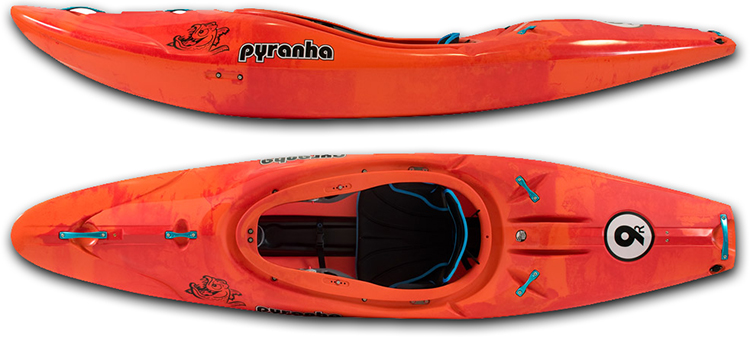
I opted for the large sized 9R II, 287cm long, partly for overnighting, but mostly because I like it’s behaviour better. This boat is nimble, it’ll turn on the spot. It doesn’t have the stern rocker that some boats do, so it tail-tap, but since I don’t often boof from ledges, I don’t care. This is a boat that asks you to keep the speed up. It has a dramatic, up-turned bow. This bow rocker results in a ton of bow lift. The stern width and volume helps keeping the boat level when coming out of holes and landing drops. The somewhat pronounced chine edge in the center of the boat helps to whip into an eddy or hold a line when charging through turbulent water. The 9R is susceptive to diagonal seems in the water. Due to the design of the boat, edging requires getting to know it, but it will reward you by offering loads of control. The characteristics of the 9R II Large compared to the medium, with my weight, perform better with regards to being sensitive to side-water at lower speeds. A more comfortable feeling. This an awesome kayak!

See the Pyranha 9R II in the surf!
![]()
Supplied by Kanocentrum Arjan Bloem.
Dagger Rewind, my river runner.
‘Riverrunning is the essential form of kayaking, is not about pushing the levels of difficulty. Riverrunning is about playful exploration of every element differential forces in the river’s currents.‘
If you are looking for slice and speed in a whitewater kayak, the Dagger Rewind is a great choice. This whitewater kayak offers a full volume bow and a low volume stern that makes it easy to get vertical on stern squirts and splats. When it comes to slicy river running kayaks, the Rewind is at the top of the food chain.
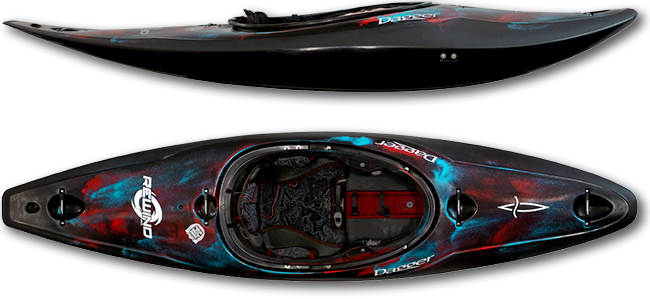
The Dagger Rewind has a planing hull rocker profile, making it ride up and over larger hydraulic features with ease. The sleek design is also fast and responsive while still feeling “forgiving enough”. Boofing the Rewind is super easy with the high-rise bow that quickly clears the drop and helps it to rise fast on rock-assist boofs. The stern has just enough volume and length to make it feel like a true river runner, but easy enough to bury in a squirt or pivot turn when you want to. The Rewind surfs short steeper features well by keeping the bow from pearling. The tapered edge profile starts at the bow, gets strongest right under the seat, then fades away at the very end of the stern, giving it a responsive feel. Initial and secondary stability seem to be spot on, stable and easy to roll. Its a really good design. And you can’t beat the Contour Ergo outfitting, with its ease of adjustability and immediate step-in comfort, and the Step-Out Safety Pillar. The low volume stern is just begging to be plunged underwater and is designed to allow the paddler to do stern squirts and get vertical on even the weakest eddy line. Lots of rocker. The extra volume in the bow feels extremely buoyant and resurfaces quickly. An awesome boat!

See the Dagger Rewind in action!
![]()
Supplied by Kanocentrum Arjan Bloem.
KSU Noctiluca Expedition, my big water boat.
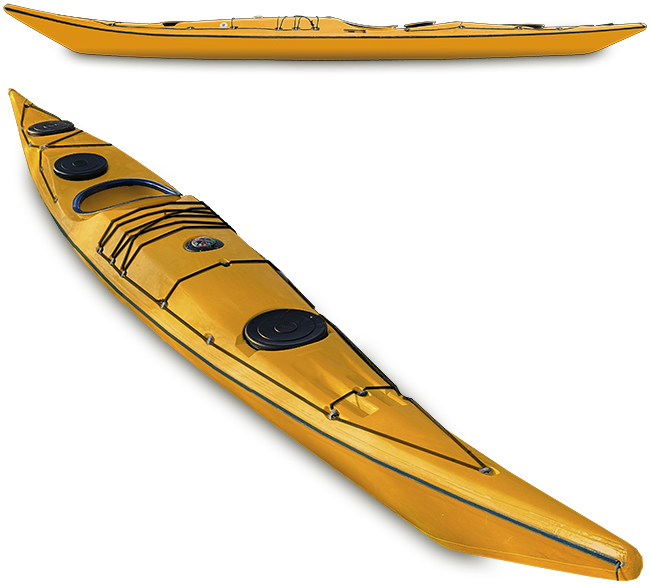
My KSU Noctiluca Expedition, made to navigate the seas. Able to stow loads of gear.
- Length x Width: 505 x 54 cm
- Weight: 23 kg
- Snug ocean cockpit 36,5 x 49,5 cm
- Retractable (Internal) Skeg
- Suunto build in Compass
- Internal Bilge Footpump
- Three waterproof compartments
- 2 Sunken Paddle Slots in bowdeck
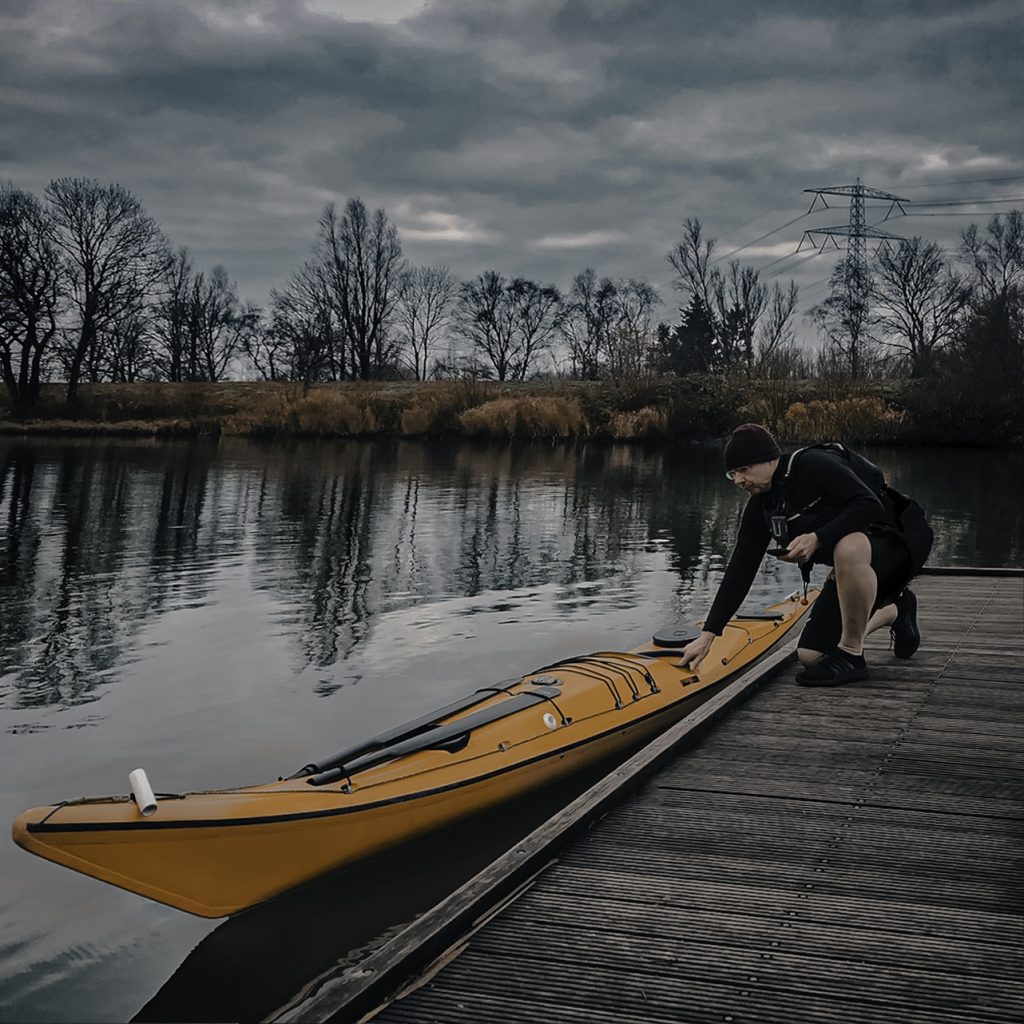
Spinera Inflatable Kayaks
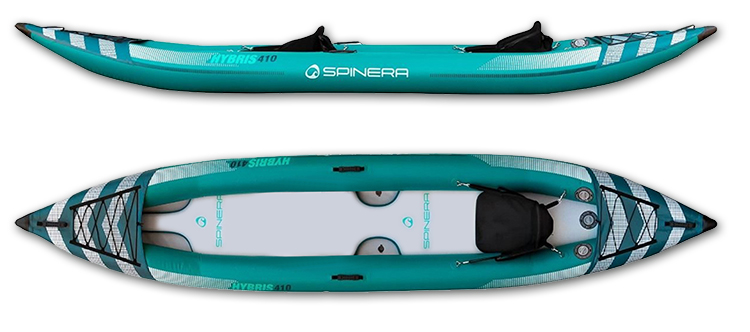
The Spinera Hybris 410 is a high quality all-round touring kayak, fit to be used on rivers, lakes and on the sea. The smooth tarpaulin underbody makes it a well gliding kayak. It comes with outfitting options up to two persons, but we use it for touring and thus as a one person plus pack boat, with a total capacity of 200 kg. This is a very stable kayak, measuring 410 x 90 cm. It has 2 side air chambers made from reinforced PVC inner tubes. The two piece floor has a reinforced tarpaulin under floor and a 8 cm High Density Dropstitch upper floor, stabilizing the kayak. It comes with 2 fins, a carrying bag made of 600D polyester and seats. It’s an easy carry weighing 16 kg at a volume of 280 liters.
The Hybris 410 needs 8 psi for the boards and 2,5 psi for the floor, which takes a little over 3 minutes to inflate the 280 liters with the airpump underneath.
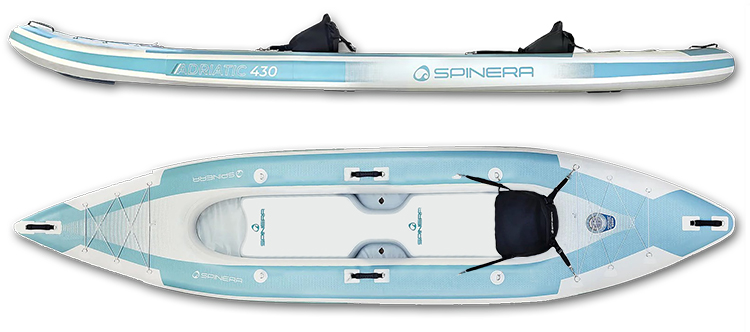
The Spinera Adriatic 430 Light is a proper lightweight kayak at 14 kg. This recreational kayak is suitable for daytrips on calm low wave waters and isn’t very susceptible to wind, all of which is due to it’s low rocker profile and limited height. Measuring 426 x 92 x 20 cm, it’s 500 liter volume can carry a max of 220 kg. The two air chambers, both double layer, are the 20 cm Double Layer Ultra light Technology outerpart and an 8 cm High Density Dropstich Floorboard on a dropstitch floor.
It needs 8 psi for the boards and 8 psi for the floor, which takes approximately 7 minutes to inflate with the airpump underneath.
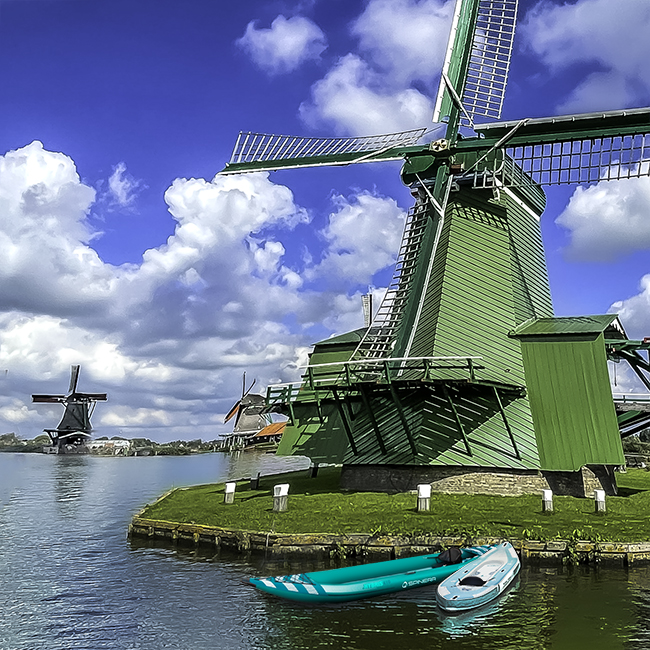
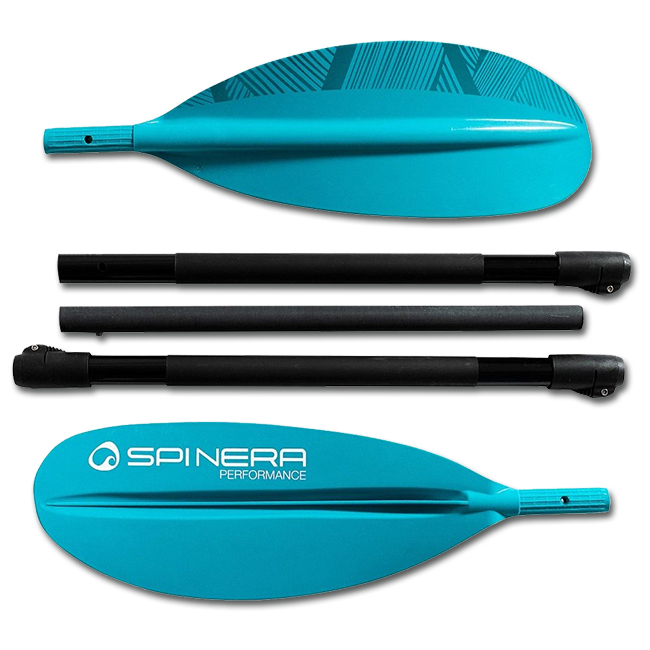 We use these kayaks with the Spinera Kayak Paddle ‘Performance’. A recreational fiberglass with reinforced Polyproylen paddle, 5 piece, adjustable up to 240cm, weight 1 kg, shaft Ø29mm and a large blade size. | 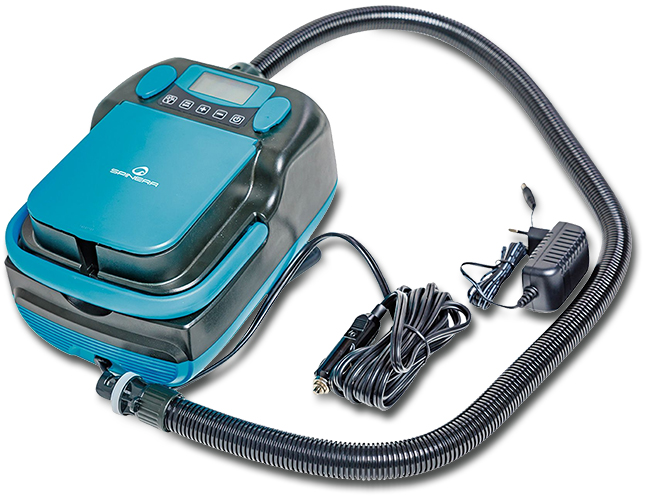 The Spinera SUP5 is a Lithium battery/6000mAH powered 220V/12V High Pressure Pump. Inflating at 350L/min (first fase: volume pump, up to 1psi) & 70L/min (second phase: pressure pump, up to 16psi), up to a set pressure. It comes with 5 different valve adapters and weighs 2,75 kg. |
My kayak history.
Prijon: T-Slalom / Avalanche / Stingray / Hai / Rockit / Performance
StipYaks: Verdon / Summit (multiple) / Ultra (multiple)
DoubleDutch: Fuego / Scimitar
Sroka Alpha Stand Up Paddle Board
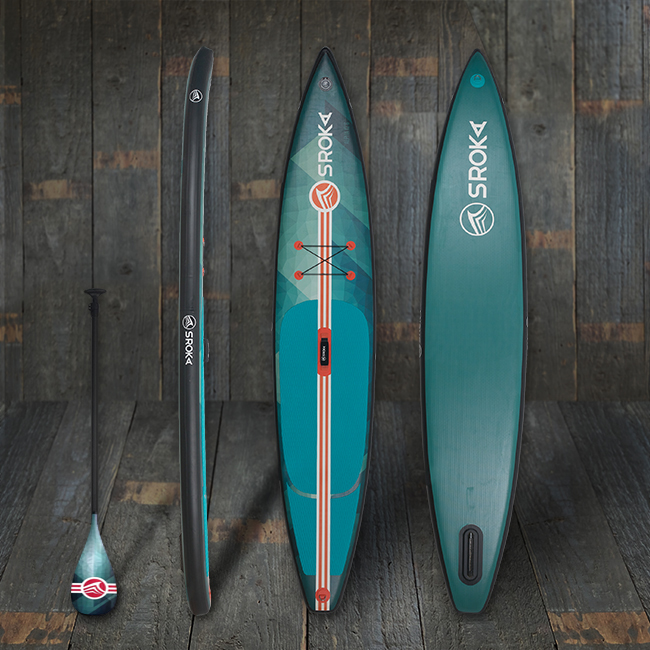
Sroka Alpha Stand up Paddle boards are high quality inflatable boards, part of their Premium series. The Alpha is a lightweight, rigid and very durable inflatable SUP with a heat-welded deck and hull, Fusion technology to optimise weight and rigidity, and 3 layers of PVC on the rails. It uses the best dropstitch on the market and professional RIB PVCs make these the strongest inflatable boards on the market. The full pack option includes a 50% carbon paddle with plastic blade (carbon look), a sup, an electric pump, a carry bag and a coiled leash. Ready to be deployed!
Paddles
Ophion Paddles
After extensive and thorough research and trying countless paddles, I found a great European paddle maker. Ophion paddles are build in a Slovenian workshop. The handling, durability, specs and build quality are second to none, so they are reliable and a solid buy.
![]()
Ophion Shuriken Whitewater Paddle
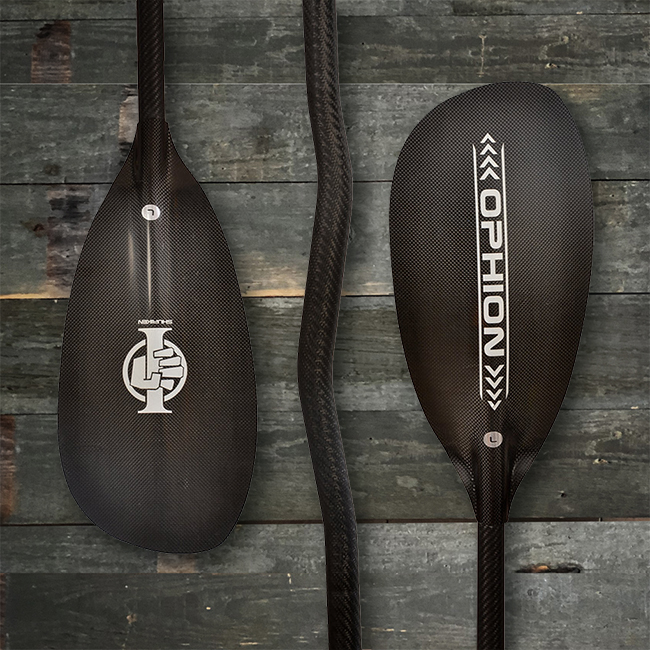
The Ophion Shuriken is a light and strong paddle with a distinct slalom pedegree, providing smooth and powerful control.
I use the Shuriken with these options:
- Carbon blade
For whitewater kayaking where power and quickness are key, you’ll want a strong material that’s still lightweight enough for quick handling. A river-running/creeking paddle will have more surface area at the upper tip. This oversized tip allows paddlers to reach the water sooner and get instant bite at the catch phase of their stroke. Carbon is an ideal material for many of us, because it has the lowest swing weight, it is the most rigid/stiff and thus it’s very direct and responsive. Ophion blades are special: Their foam core has a composite reinforcing web within the foam to add to its structure and strength. - Large blade 760cm2
A blade with more surface area will push more water, but it also needs a more powerful paddler. Smaller and less strong paddlers may find that the smaller 695cm2 blade puts less stress and strain on the body while allowing more efficient strokes. - Carbon Shaft
A stiff, lightweight paddle will lead to less fatigue. The stiffer carbonmaterial will flex less, causing less water to “escape” from the blade face, requiring less energy from your stroke to create more motion. Besides that these are the strongest and stiffest shafts. One-piece paddles are the best choice for whitewater paddles, being much more durable and strong. - Ergonomic Neutral Bent Shaft
This is a non trailing ergonomic shaft, so the blades are in line with the shaft. This crank doesn’t give you extra control over the paddle, it simply lets your hand sit at a more comfortable angle on the shaft, reducing the strain put through your wrists and elbows. It’ll also keep you from holding on too tightly. A good option if you’re getting older. - Length 196 cm, right handed
River running paddles need to have sufficient length due to the importance of the “catch.” The catch is where the blade first enters the water. Generally, 194 cm fits shorter people, 196 cm fits those of average height - Feather 30o
For whitewater kayaking, a thirty- or forty-five-degree twist is common. A lower offset means less repetitive twisting of the wrist. For general whitewater paddling 30o is my choice, but hey, I’m old and used to this. - Power grip
This is an option unique to Ophion. It is a non-slip coating providing better grip. - Total weight: 1120g
Ophion Enduro Whitewater Paddle
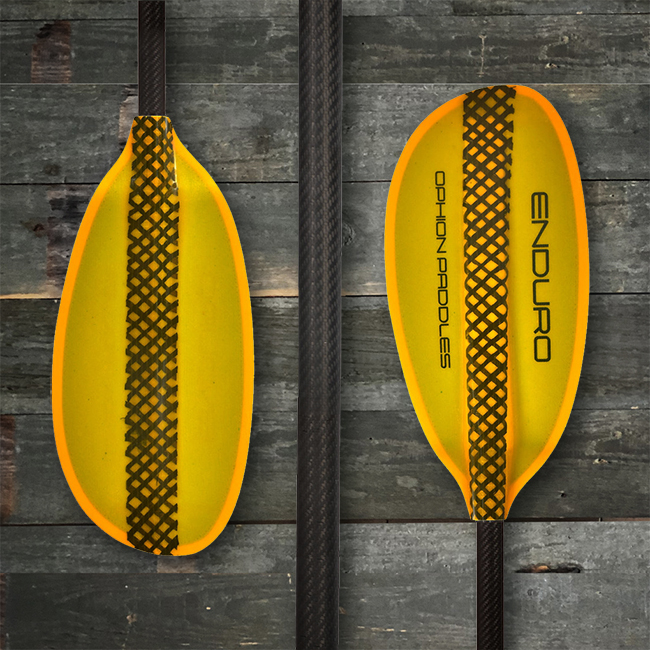
The Ophion Enduro is a true workhorse, built to last! This is a light and strong, allround whitewater paddle, with a floating feeling.
So, I use the Enduro with these options:
- Hybrid blade
For whitewater kayaking where power and quickness are key, you’ll want a strong material that’s still lightweight enough for quick handling. A river-running/creeking paddle will have a more surface area at the upper tip. This oversized tip allows paddlers to reach the water sooner and get instant bite at the catch fase of their stroke.
The Enduro is built to last, even with for daily use, by professionals. The base of these blades is made of Airex foam core, edge protected with a very high abrasion resistant dynel cord. The central rib is reinforced with a diagonal braided Carbon, preventing twisting of the blade to ensure a stabile stroke. The outer layer is made from fine Fiberglass for a good flex balance: It’s slightly more flexible than a Carbon blade, which can be good on sensitive wrists and joints, though does sacrifice some power in your stroke. Regardless of the flexibility, this is a very stable paddle. - Carbon Shaft
A stiff, lightweight paddle will lead to less fatigue. The stiffer carbonmaterial will flex less, causing less water to “escape” from the blade face, requiring less energy from your stroke to create more motion. Besides that these are the strongest shafts. One-piece paddles are the best choice for whitewater paddles, being much more durable and strong. - Straight Shaft
The proofen shaft. Straight, strong, no getting used to. The match for a ‘work horse’ paddle. - Length 196 cm
River running paddles need to have sufficient length due to the importance of the “catch.” The catch is where the blade first enters the water. Generally, 194 cm fits shorter people, 196 cm fits those of average height - Feather 30o
For whitewater kayaking, a thirty- or forty-five-degree twist is common. A lower offset means less repetitive twisting of the wrist. For general whitewater paddling 30o is my choice, but hey, I’m old and used to this. - Large blade 750cm2
A good size blade like this will push more water, but it also needs a more powerful paddler. Smaller and less strong paddlers may find that a smaller blade puts less stress and strain on the body while allowing more efficient strokes. - Power grip
This is an option unique to Ophion. It is a non-slip coating profiding better grip. - Total weight: 1100g
Ophion Gendaj Touring Paddle
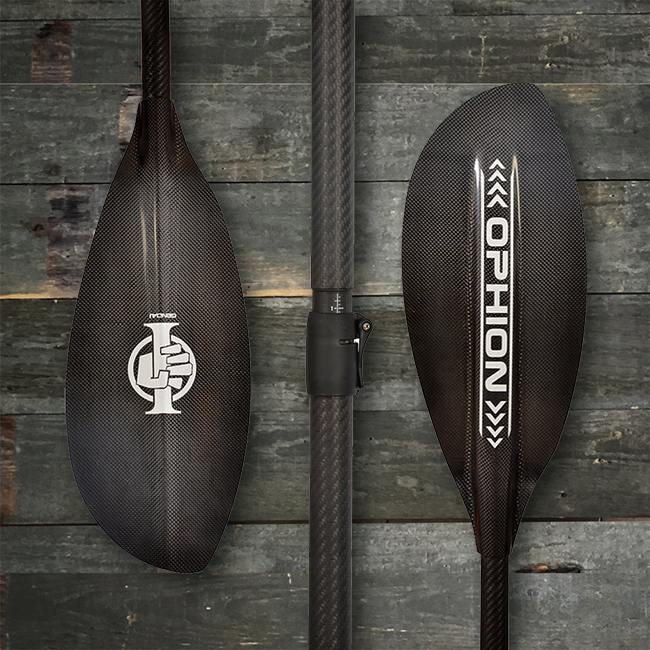
The Ophion Gendaj 180 is a high angle touring paddle, that’s very light and efficient.
(Most people enjoy the low-angle style of paddling. Ophion offers a Low angle model is well: the Gendaj 160)
So, I use the Gendaj 180 with these options:
- Total weight: 700g (+100g for the optional split system)
This is a very light paddle. The one piece version weighs a mere 700 grams! - Carbon blade
For touring and sea kayaking, you’ll likely prioritize lightness and efficiency over strength. Carbon though is an ideal material for many of us, it combines lightness, efficiency ánd strength. - High Angled blade
The shape of these blades are designed for high angle paddling. The difference between high and low angle paddling is the angle at which your paddle hits the water. If your upper hand goes above your shoulder, that’s high-angle paddling. This paddle is perfectly balanced and shaped for powerful efficient strokes and move a lot of water with each stroke. High-angle paddling is a more aggressive style that targets on performance and is is common for sea kayaking, fitness/training and kayak surfing. A high angle stroke requires special skills.
Low-angle is about efficiency, the technique is less demanding and can keep you going for hours. - Medium Sized blade 680cm2
This medium size blade is an excellent size for long trips without using too much energy, even with a well packed kayak. - Carbon Shaft
A stiff, lightweight paddle will lead to less fatigue. The stiffer carbonmaterial will flex less, causing less water to “escape” from the blade face, requiring less energy from your stroke to create more motion. Besides that these are the strongest shafts. - Straight Shaft, with split system
The split system allows the paddle to break down in half. It is adjustable in lenght by 10cm and blade feather on any degree. I choose for a split system because of the variable feather. - Length 220 cm
With the split system this paddle is extandable for an extra 10 cm. - Standard Feather 45o
I like my touring paddle to have a 45o feather in most conditions. But (being a high angle paddler) I like a 90o feather in upwind conditions, so my upper blade doesn’t catch as much wind. The split system allows me to change the feather on the go. - Power grip
This is an option unique to Ophion. It is a non-slip coating profiding better grip.
Gram 900D Carbon, greenland style paddle
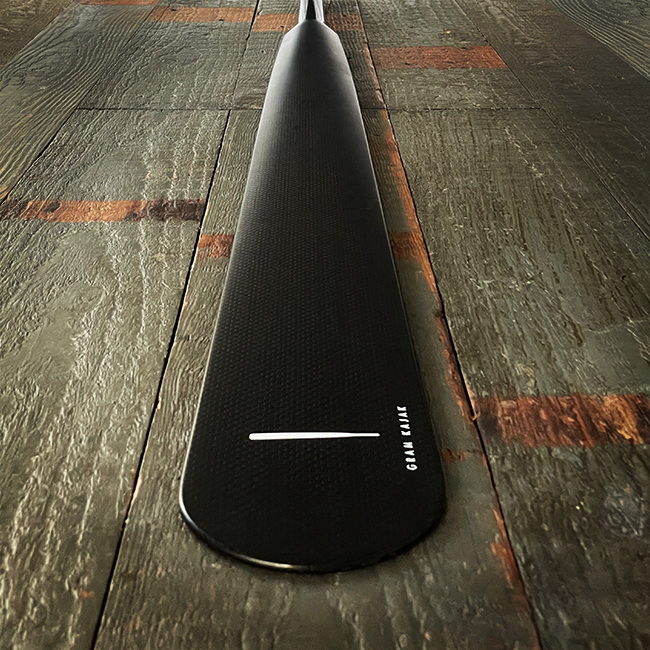
The best looking Greenland paddle ever made?
Lars Gram makes these paddles close to, if not, perfect.
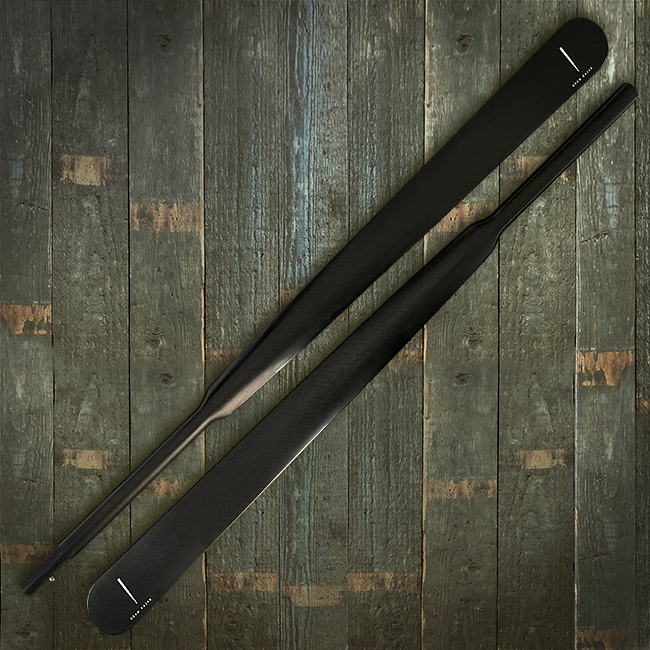 | 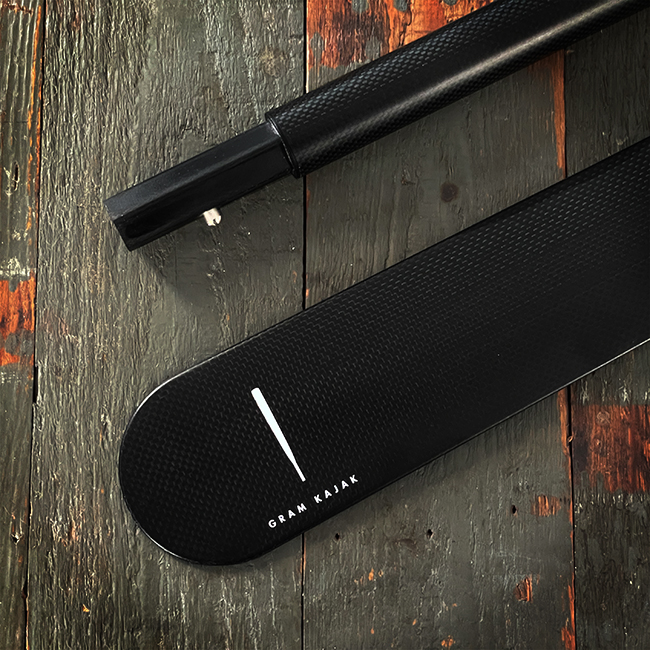 |
I use the two piece ‘shouldered’ version. It’s a hollow 100% carbon paddle, weighing just over 500 grams. My paddle is 224 cm, with a loom width of 58 cm.
The very comfortable handle has a 31x36mm oval shape, with a non-blistering high-friction surface. The hexagonal shaped ferrule is very secure and guarantees a strainless joint. The paddle comes with a well made bag.
